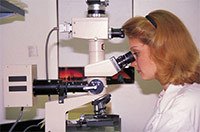Ultraviolet Blood Irradiation Therapy
The curative power of different colors of light through photoluminescence therapy for cancer.

Photoluminescence Therapy
Ultraviolet Blood Irradiation, also called Photoluminescence Therapy, is intravenously applied ultraviolet energy. Due to its profound photochemical, biochemical and physiological effects it has been of great value in a wide variety of diseases.
Abundant Literature reports on the successful therapeutic use of Ultraviolet Blood Irradiation over many decades.
 Ryberg Finsen is considered the father of Ultraviolet Blood Irradiation. In the 1890s, he treated various skin conditions with concentrated light radiation and discovered the curative power of different colors of light. He and his successors reported a success rate of about 98% with lupus vulgaris, a tuberculosis-like disease of the skin and mucous membranes.
Ryberg Finsen is considered the father of Ultraviolet Blood Irradiation. In the 1890s, he treated various skin conditions with concentrated light radiation and discovered the curative power of different colors of light. He and his successors reported a success rate of about 98% with lupus vulgaris, a tuberculosis-like disease of the skin and mucous membranes.
In 1903 he was awarded the Nobel Prize in Medicine for his phototherapy.
In 1928, E. Knott, M.D., Seattle, Washington, developed this therapy further and used a device that made extracorporeal ultraviolet blood irradiation possible.
In the 1930s, 1940s and 1950s, E. K. Knott, V. Hancock and other physicians applied ultraviolet blood irradiation successfully with a variety of conditions. There are published reports of treatment results with bacterial diseases, viral infections including acute and chronic hepatitis, poliomyelitis, encephalitis, overwhelming toxemias, rheumatoid arthritis and many others. With the advent of the Salk vaccine against polio and the antibiotics against bacterial infections, Ultraviolet Blood Irradiation fell in disuse until recent years.
In Europe, since the early 1950s, Josef M. Issels, M.D. administered Ultraviolet Blood Irradiation, or Photoluminescence Therapy, as one important component of his comprehensive immunobiologic treatment program to thousands of his patients suffering from cancer and various immune disorders. He implemented this therapy for the following reasons:
Research had shown that one of the major contributing factors to the development of these diseases is the impairment of cell respiration by oxygen deficiency. The Nobel laureate Otto Warburg found that in malignant diseases the oxidation process in cells is blocked and energy is produced by fermentation.
Ultraviolet Blood Irradiation increases venous oxygen in patients with depressed blood oxygen values, enhances the resistance to acute and chronic viral and bacterial infections, has rapid detoxifying and anti-inflammatory effects and has a regulatory influence on the autonomic nervous system. The activation of the metabolism can last up to 42 weeks after completion of treatment.
In hematology and immunology the possibilities of ultraviolet energy to produce beneficial changes in blood components have been evaluated. Ultraviolet Blood Irradiation has been known to inactivate viruses while preserving their ability to be used as antigens in the preparation of vaccines. Photoluminescence therapy has shown to modulate the immune response by changing the antigenic structure in blood cells.
At Issels Integrative Oncology Centers We Administer Ultraviolet Blood Irradiation in Two Different Ways:
1. The Knott Technique
Depending on the individual patient's condition and body weight, a certain amount of venous blood is withdrawn by venipuncture into a transfusion flask or syringe containing a small amount of an anticoagulant such as heparin or sodium citrate.
The blood flows through a quartz glass irradiation chamber where it is exposed to a controlled amount of ultraviolet energy in a therapeutic band generated by specialized lamps.
As it returns to the body in a closed circuit, the blood is irradiated a second time for optimum results. This procedure takes about 30 minutes. The number of treatments depends on individual needs.
2. The Extracorporeal Photopheresis
The more complex method is the Extracorporeal Photopheresis (ECP) which is FDA approved for cutaneous T-cell lymphoma due to the research by CL Berger, RL Edelson, et al. at Yale University. This is a leukapheresis-based procedure which modulates the immune response and has been highly successful in the treatment of cutaneous T-cell lymphoma (CTCL), autoimmune disease and graft-versus host disease.
Both of the above mentioned methods of Ultraviolet Blood Irradiation have shown their very beneficial results in cancer and autoimmune disease without any harmful side effects.
With our cancer patients we administer the Extracorporeal Photopheresis as the first step in the preparation of our autologous (from the patient's own blood) vaccine and cell therapies.
During the Extracorporeal Photopheresis the blood passes through an ultraviolet light chamber, which has an enormous immune boosting effect. In the cell separator, i.e. the leukapheresis device, white blood cells, the cells of the immune system, such as monocytes and lymphocytes, are separated from the blood which is returned to the body in a closed circuit.
Our immunologist cultures the separated monocytes with special cytokines and growth factors in the presence of the patient's own cancer cells into very potent antigen presenting dendritic cells. When this powerful Dendritic Cell Vaccine is injected into the body it has the potential to invoke an anti-tumor immune response.
The separated lymphocytes are cultured to Lymphokine-Activated Killer (LAK) Cells, which act in concert with the Dendritic Cell Vaccine in the attack against the patient's cancer cells.
Literature:
- Edelson, R. (1991) "Photopheresis : A Clinically Relevant Immunobiologic Response Modifier", Annals, New York Academy of Sciences, Dec. 30:636
- Edelson, R. (1991) "Photopheresis: A New Therapeutic Concept", The Yale Journal of Biology and Medicine 62:565-77
- Edelson, R. et al. (1987) "Treatment of Cutaneous T Cell Lymphoma by Extracorporeal Photochemotherapy", New England Journal of Medicine 316:297-303
- Edelson, R. (2001) "Cutaneous T Cell Lymphoma, The Helping Hand of Dendritic Cells", Yale University Comprehensive Cancer Center and Department of Dermatology, New Haven, Connecticut 06520, USA
- Issels, J.M. (1999) "Cancer: A Second Opinion", Avery Publ Group., Penguin Putnam
- Knott, E.K. (1948) "Development of Ultraviolet Blood Irradiation" , Am. Jrl. Surg.Vol. 76, No. 2, Aug. 1947
- Koch, W.F. (1955, 1958) "The Survival Factor in Neoplastic and Viral Diseases", Vanderkloot Press, Detroit, Michigan
- Olney, R.C. (1955) "Treatment of Viral Hepatitis with Ultraviolet Blood Irradiation", Journal of Surgery
- Taylor, A., Gasparro, F.P. (1992) "Extracorporeal Photochemotherapy for Cutaneous T Cell Lymphoma and other Diseases", Seminars in Hematology 29: 132-42
- Warburg, O. (1950) "On the Origin of Cancer Cells", Science Magazine, Volume 123, 3191
Revised and Published in 2012